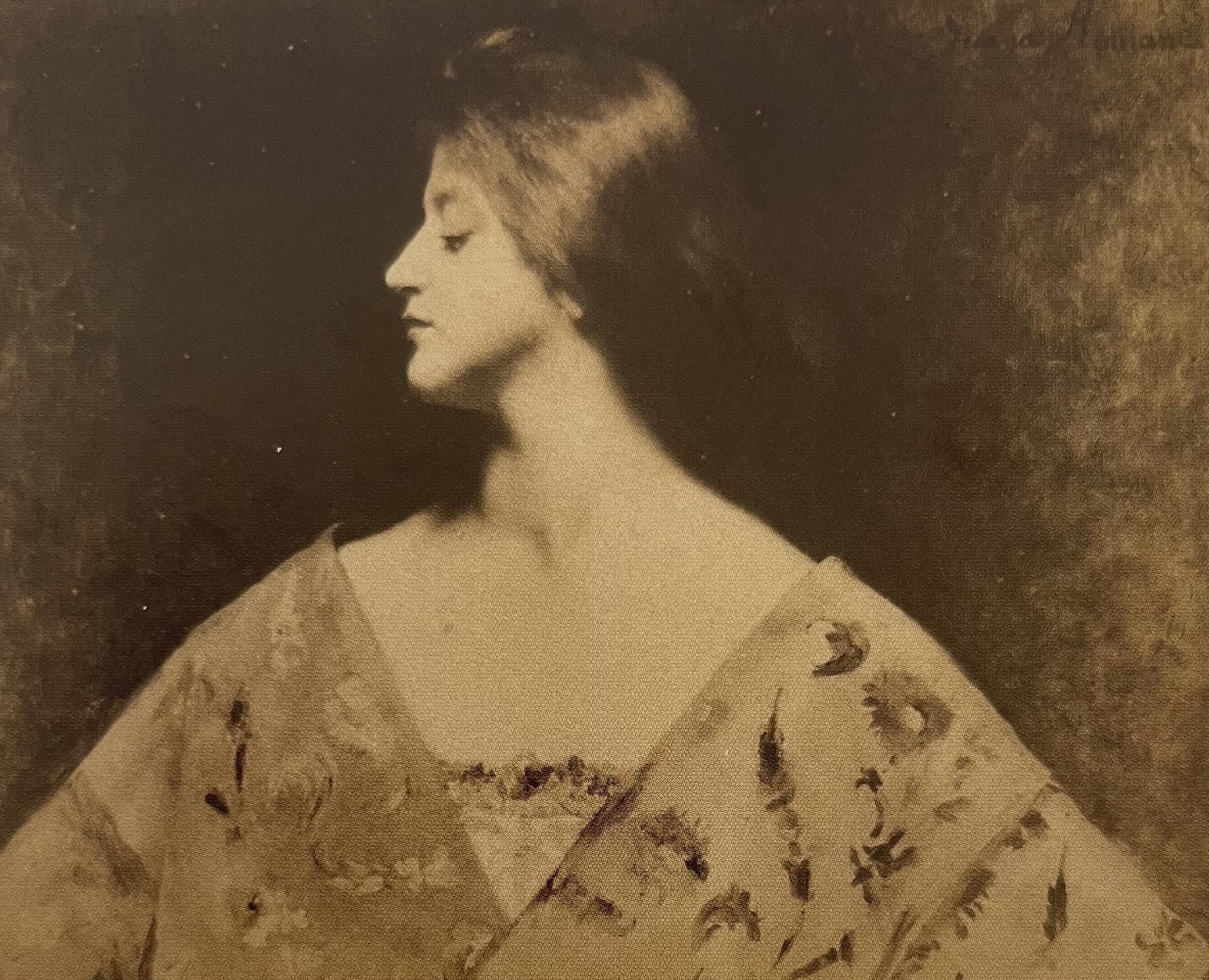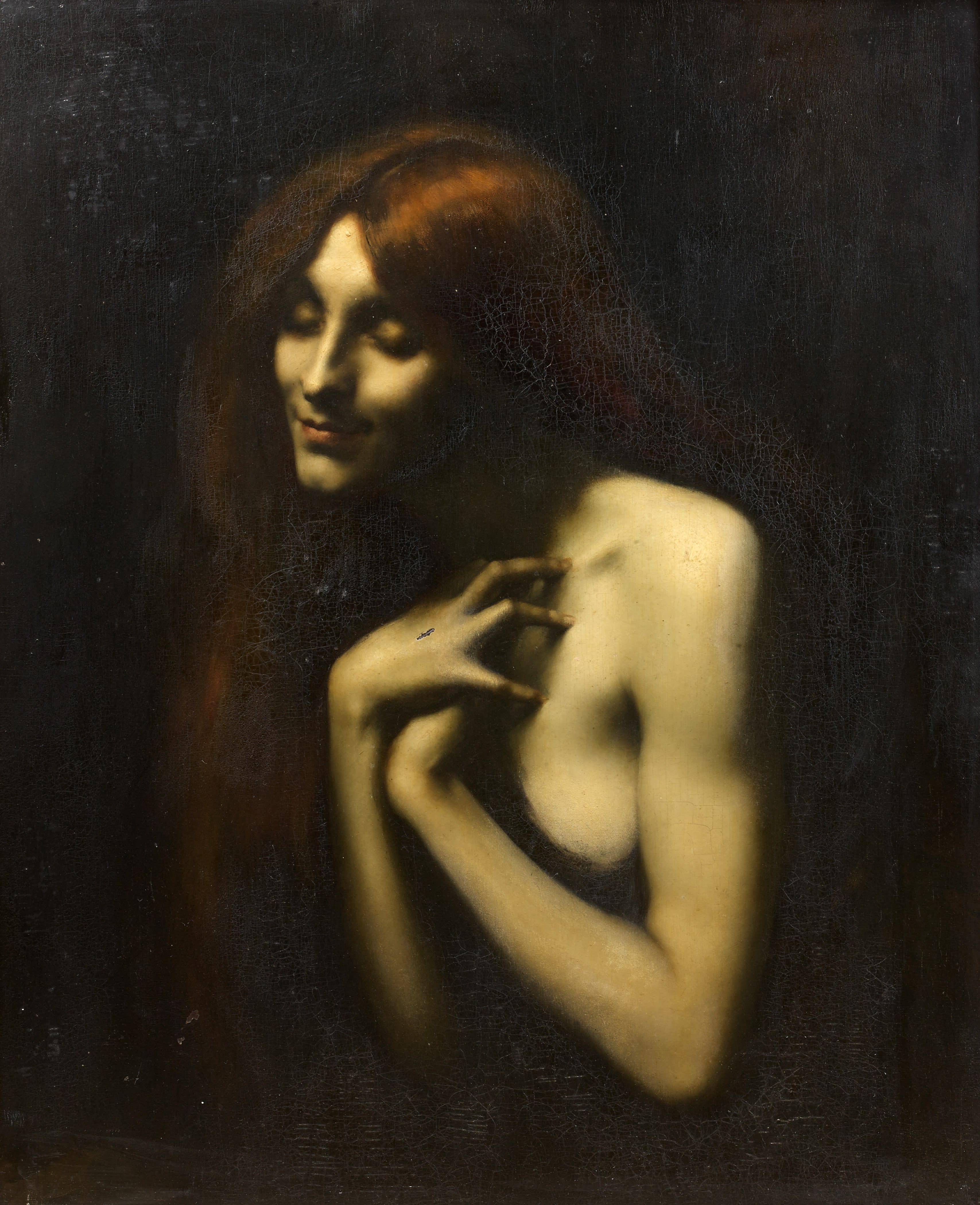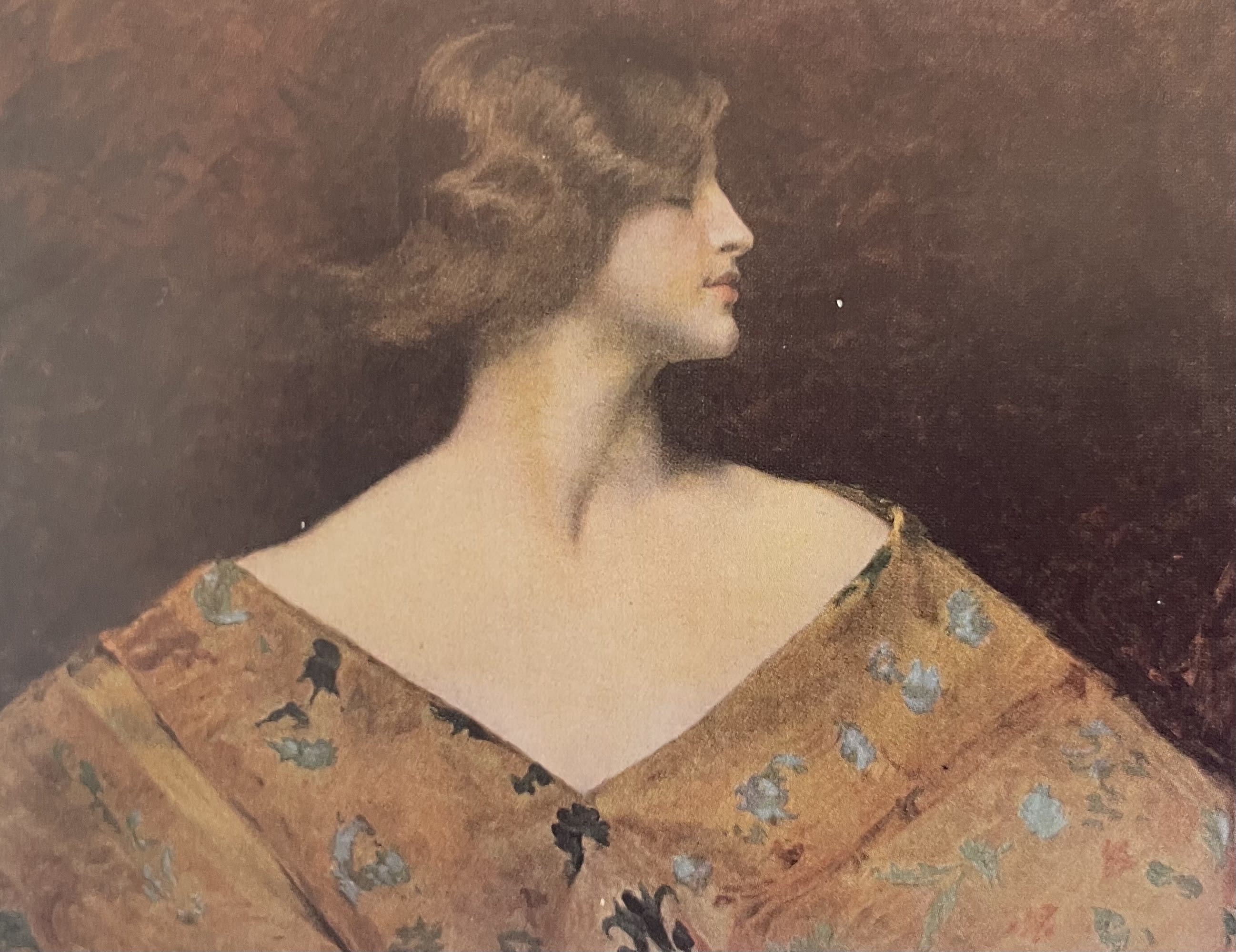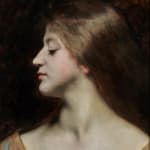Juana Romani (1867 - 1924)
La Vénetienne
Inscribed on the reverse: Henner f.
Oil on panel, cut down
42 x 33.7 cm. (16 ½ x 13 ¼ in.)
La Vénetienne
Inscribed on the reverse: Henner f.
Oil on panel, cut down
42 x 33.7 cm. (16 ½ x 13 ¼ in.)
Juana Romani’s depiction of a porcelain skinned beauty turning her head in profile is a significant rediscovery within the artist’s oeuvre, marking an important step in her stylistic development as well as shedding light on her links with Jean-Jacques Henner. The painting, cut down on all sides, is known as La Vénetienne and is visible behind the artist in the famous photograph taken of her by Edmond Bérnard in 1892 in Ferdinand Roybet’s studio on rue du Mont-Thabor (fig. 1). La Vénetienne is also known from a black and white photograph in the archives of the musée Roybet Fould, in which Romani’s cursive signature is clearly visible at the upper right.

Fig. 1, Emile Bernard, Mlle Juana Romani (detail), 1892, albumin print, Petit Palais
Why was the panel cut down? Damage would seem to be the most likely explanation. However, though extreme, it might have been reduced by an unscrupulous dealer or owner who wanted to totally remove all traces of the signature and then sell the work as a Henner. Indeed, ‘Henner f.’ has been inscribed onto the reverse, confirming that at one point Romani’s painting was passed off as a work by her master. Henner’s paintings were more valuable than Romani’s in their lifetimes (and indeed only now is that dynamic reversing) and, as we shall see, Romani’s style in the late 1880s and early 1890s was close enough to Henner’s that an untrained eye could be fooled by this kind of duplicity. Paradoxically, though, La Vénetienneis a key work in Romani’s stylistic evolution away from Henner. Even in today’s art market works by Romani, sometimes with fake signatures or inscriptions, mistakenly pass under the guise of Henner.[1] This is understandable given the obscurity she fell into after her breakdown in 1906 and only now is Romani starting to receive the scholarly attention which enables the separation of her work from that of Henner.
From 1887 Romani spent time in Henner’s studio not only as a model but also as a student and the two developed a closeness, perhaps linked by a shared love of Italy, that would remain until Henner’s death in 1905. Indeed, out of all the artist’s Romani befriended, she seems to have learned the most from Henner, telling him at one point that she ‘wanted to visit your studio everyday’.[2] Her early Salon entries were criticised for their reliance on Henner’s distinctive idiom. This was justifiable, as Romani’s earliest works, depicting flame-haired femmes fatales bathed in chiaroscuro and emerging from the darkness, did certainly lean heavily on Henner, if not technically then certainly compositionally (fig. 2). Two separate reviews of the Salon of 1890 called both of her inclusions there ‘pastiches’[3] of Henner and one critic even went so far as to say, ironically enough given the discussion in the above paragraph, that Romani had ‘opened a shop for the production of fake Henners’![4]

Fig. 2, Juana Romani, Marie Madeleine, c.1890,
oil on panel, 63 x 50 cm, Private Collection
Although these Salon entries were lauded by other critics, who eulogised her virtuoso technical skills, the harsher reviews probably spurred Romani on to develop her own distinctively individual style and by the mid 1890s she had ruptured quite completely with Henner. La Vénetienne, alongside the related Bianca Capello (fig. 3) also of 1892, is an important milestone in this development. Whilst still reminiscent of Henner in some ways, most notably in the earthy palette and sense of enigma, here we start to see more of a synthesis of various influences independent of those of Henner and Roybet. Evoking a temporality reminiscent of Gothic or Byzantine art, Romani experiments with a horizontal format, allowing her to create a voluminous drapery which hangs off the wide and sloping shoulders of her figures. Though no longer visible due to its fragmentary nature, in La Vénetienne one would have originally been able to see the skill and delight with which Romani accurately renders luxurious fabrics, a talent for which the artist would soon be widely fêted. The title too, and that of Bianca Capello, evinces Romani’s fascination for the powerful and seductive women of the Renaissance courts of her home country.

Fig. 3, Juana Romani, Bianca Capello, 1892, oil on panel, dimensions and
location unknown
Romani built upon all these themes, taking them further in the years to come and she would, in time, have her own pasticheurs, imitating her distinctive style. Indeed, by 1901, when Romani was at the height of her short-lived fame, the critics Félix Gautier and Louis Papon felt able to talk of a style ‘Romani’ just as one was able to discuss a style ‘Henner’ or ‘Roybet’.[1] The year 1892, within which La Vénetienne was painted, was a crucial moment in this artistic independence, and her Salon entries for that year were described as ‘remarkable’ works by a ‘young and brilliant artist’.[2]
[1] F. Gautier and L. Papon, ‘Autours des Salons de 1901. Intérieur d’artistes’ in La Vie illustrée, no. 133, 3 May 1901, p. 71.
[2] Anonymous author, ‘Paris-Noêl’ in L’Art français, no. 268, 23 December 1892, n.p., ‘La jeune et brilliant artiste…expose elle-même deux figures remarquables…’.
[1] The same phenomenon may also be observed in relation to Romani’s other teacher, and romantic partner, Ferdinand Roybet, whose name is also sometimes inscribed on her works.
[2] É. Durand-Gréville, Entretiens de J-J. Henner. Notes prises avec Émile Durand-Gréville après ses conversations avec J-J. Henner (1878-1888), Paris 1925, p. 208, ‘ Je voudrais rester tous les jours dans votre atelier’.
[3] A. Wolff, ‘Le Salon’ in Le Figaro, no. 120, 30 April 1890, p.2; P. Véron, ‘Le Salon en partie double’ in Le Charivari, 1 Mai 1890, p. 1.
[4] M. Champimont (René Morot), ‘Le Salon’ in Le Voleur Ilustré, no. 1714, 8 May 1890, p. 297, ‘[Romani] a ouvert une échoppe pour la fabrication du faux Henner’.



